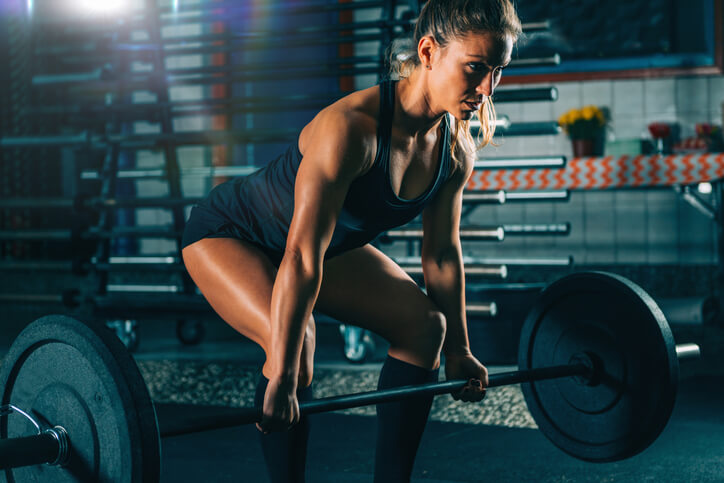
If you were going to do one exercise for the rest of your life, it should be the deadlift. It’s that good.
The exercise represents one of the most innate human movement patterns, training the body to act as one cohesive, badass unit. “Although many use the deadlift to improve glute and hamstring strength, with the lift, you are really making gains globally,” says physical therapist and strength coach Mariel Schofield, P.T., D.P.T., C.S.C.S.
After all, the exercise trains more muscles throughout the whole body—while allowing you to use heavier weights—than any other move. More body parts + higher intensities = better results.
Deadlift Benefits
Better Athleticism
Whether you’re running marathons or covering second base, deadlifts will help get you to the next level. “Deadlifts build power, the lifeblood of any successful athlete,” explains women’s strength coach Allison Tenney, C.S.C.S. The deadlift’s hip-hinge (translation push your butt back and then thrust!) is your body’s ultimate power move, propelling running strides, jumps, changes in direction, and other lifts like squats and step-ups.
Superior Cardio
Pull heavy and you’ll boost your heart-health in a major way. In one Appalachian State University study, women who performed strength training improved their blood pressure better than those who stuck with traditional cardio. That may be because lifting acts as a sort of super high-intensity-interval training, spiking your blood flow and heart rate to train your body’s arteries to more easily dilate. (Buh-bye, long elliptical sessions!)
RELATED: The Most Underrated Form of Cardio: Strength Training
Stronger Bones
Bones are stubborn. To strengthen them, you have to load them… a lot… estimates suggest with at least 10 percent of the weight it would take to land you in a cast. Lucky you that heavy deadlifts can load the spine and hips, which are at the greatest risk of poor bone mineral density, osteoporosis, and fractures down the line, with up to five to eight times your bodyweight, meaning they are ideal for bone strengthening. After each lift, specialized cells called osteoblasts lay down collagen in the most-stress areas of the bone. Once calcified, those cells turn to rock-hard bone.
Feeling Badass
“There’s a transformation when women start picking up heavy shit,” says Tenney, explaining that deadlifts come with some of the biggest improvements in women’s self-esteem and sense of strength. That might be because the body is naturally so strong at deadlifts. “You can get to a place where you are easily deadlifting more than your body weight, which is a cool thing in itself,” she says.
Related: Are Deadlifts and Squats Mandatory?
A Way Stronger Core
According to a 2017 International Journal of Sports Physical Therapy study, deadlifts kick the plank (with opposite arm-leg lifts, for that matter!) at training the transverse abdominis. The most deep-lying part of the abs, the muscle acts as a sort of internal corset, keeping your torso strong and tight.
Easier Fat Loss
By working every muscle and jacking your heart rate up (seriously, sets of six will wind you!), deadlifts burn major calories both in the gym and after you cool down through post-exercise excess oxygen consumption, Schofield says. EPOC for short, it refers to all of the energy your body uses up in the recovery process.
Glorious Glutes
Deadlifts are a hip-dominant move, meaning your glutes and hamstrings are doing the brunt of the work with each rep, Tenney says. That makes them a mainstay of any butt workout—adding size and firmness to the area for a visual perk.
Back-Pain Relief
Forget what you’ve heard. Deadlifts can decrease pain in people with low-back problems, per the Journal of Strength and Conditioning Research. It can also help reduce the risk of pain starting in the first place, Tenney says. The move strengthens the erector spinae, a group of muscles that start in the low back and run up the spine to stabilize and protect it, scaffolding-style.
Your Form, On Lock
Setup
+ Feet hip-width apart
+ Barbell over the center of feet
+ Shoulder blades over barbell
+ Push butt back as far as possible
+ Imagine you’re trying to hover over a nasty public toilet seat
+ Minimal knee bend – these aren’t squats!
+ Hands shoulder-width apart
+ Neutral spine; don’t look at the mirror
+ Take a big inhale
+ Pin shoulders back
+ Take the slack out of the bar!
Pull/Extension
+ Skim the bar up your legs
+ Push the floor away
+ Squeeze glutes
+ Stand up as tall as possible
+ Exhale forcefully through mouth
+ Your arms are ropes
Lowering
+ Lower slowly and under control – no dropping!
+ Resist the urge to round your back
+ Skim the bar back down your legs
+ Inhale
More Deadlift Variations You Need to Try
This single-leg switcharoo helps improve stability, balance, oblique strength, and ID any strength differences between sides.
Kettlebell Deadlift
If you have good hamstring mobility, this deadlift version is awesome for at-home use.
Cable Pull-Through
It might not look like a deadlift, but it is! Learn picture-perfect deadlifting form without putting weight on the spine.
Dumbbell Romanian Deadlift
An ideal variation for at-home workouts where you might just have dumbbells. Also great for newbies who might not be deadlifting 45-plus pounds yet. (That’s standard barbell weight.)